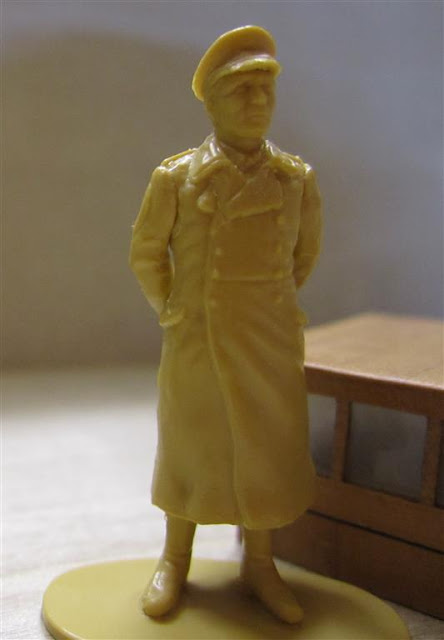In early May
1845, just prior to the departure of HMS Erebus and Terror on their final
voyage, a number of the Franklin Expedition officers sat for a remarkable series of
daguerreotype portraits. Taken by the renowned London daguerreotypist Richard
Beard on the deck of HMS Erebus, most of the images include a cloth backdrop
which obscures the ship’s architecture. However, one portrait, of
Lieutenant Henry T. D. Le Vesconte, did not use a backdrop; this omission resulted in the only
known contemporary “photographic” image of Erebus or Terror.
In the image, Le Vesconte appears to be sitting on the starboard quarterdeck of HMS Erebus, just in front of the ship’s mizzen mast, skylight, and wheel (note the original daguerreotype is a reversed image). Out of frame, in front of his left elbow, would have been a small charting table bolted to the deck. Le Vesconte may have used a stool or chair associated with that table to sit for his photograph.
I believe
this location was carefully chosen for the photograph. In the Royal Navy,
the starboard quarterdeck was considered to be an almost sacred location - reserved
only for the ship’s master and his officers. On Erebus, it was the location
where Franklin and his senior officers would have issued orders, considered
routes, and charted coastlines. It was the nerve-centre of the entire Franklin
expedition. It is astonishing that such an image has survived to the present
day.
Components in the Le Vesconte Scene
I have been
modelling 1/48 scale versions of the ship's wheel and skylights for my HMS
Terror project, and realized that I had the opportunity to recreate the famous
Le Vesconte image. To model these fittings, I began with the original ship’s
plans and used the Le Vesconte daguerreotype to provided key information.
Further information was gleaned from the 1839 Erebus model in the collections
of the National Maritime Museum. As I will describe below, one of these
structures was recently discovered by Parks Canada near the wreck of HMS
Erebus and the publicly released image of that artifact provided critical
information.
The Skylights
HMS Erebus
and Terror each had two skylights located on the aft of the upper deck. Both follow
a design originally adopted by HMS Terror in 1836. The sides of the skylights
were rimmed with panes of glass to allow sunlight into the captain’s cabin
and officer’s mess. Unusually, their tops had no peak or even a slight camber –
attributes confirmed by the daguerreotype and the NMM model of Erebus. Interestingly,
the daguerreotype indicates that the panes were not protected by brass rods as
was standard on many Royal Navy vessels of the era – an indication of the peaceful
aims of the expedition. In addition, the aft skylight on HMS Trincomalee, which is very similar to those
used on HMS Erebus and Terror, provided important details for my recreation.
The
1836/1837 and 1839 plans for Terror/Erebus indicate the skylights may have had collapsible
sides, at least on the starboard. This would have permitted ventilation, if
necessary, though the plans seem to indicate the ultimate aim was to enable the
skylights to be used as makeshift companionways. In this scenario, it is
likely the roofs of the skylights would have been removable. I opted not to
model these aspects of the skylights, as I had no information on how these
features were designed.
 |
| Laser cutting the parts for the skylights. The wood is swiss pear. |
 |
| Parts compared to the plans. |
 |
| The completed skylights. |
 |
Mini-Crozier stands next to the largest skylight. The window panes have been
sanded on their interior sides to simulate frost. |
The Ship’s
Wheel
The
1836/1837 and 1839 plans of HMS Terror and Erebus show that their wheels were
slightly smaller than those typically used on Royal Navy ships, being more
consistent with those used on merchant vessels of similar size. The recently recovered portion of Erebus’ wheel, as well as the Le Vesconte daguerreotype, reveal that the wheel itself was relatively plain and was held together by
copper alloy screws or nails. Fine examples of this type of wheel can
be found today on HMS Unicorn and HMS Trincomalee. Trincomalee’s wheel is perhaps closest in design, with distinctive grooved felloes nearly identical to
those on the HMS Erebus wheel found by Parks Canada.
Like most large
Royal Navy vessels, Erebus and Terror’s wheels had ten spokes, each radiating
at 36 degrees from the barrel. Usually, survey vessels ships of this size would
have had an eight spoke wheel; the extra spokes would have substantially
increased the strength of such a small wheel, and perhaps it was deemed
necessary for arctic exploration.
 |
| Mini-Crozier stands at his post on Terror's quarterdeck. |


















